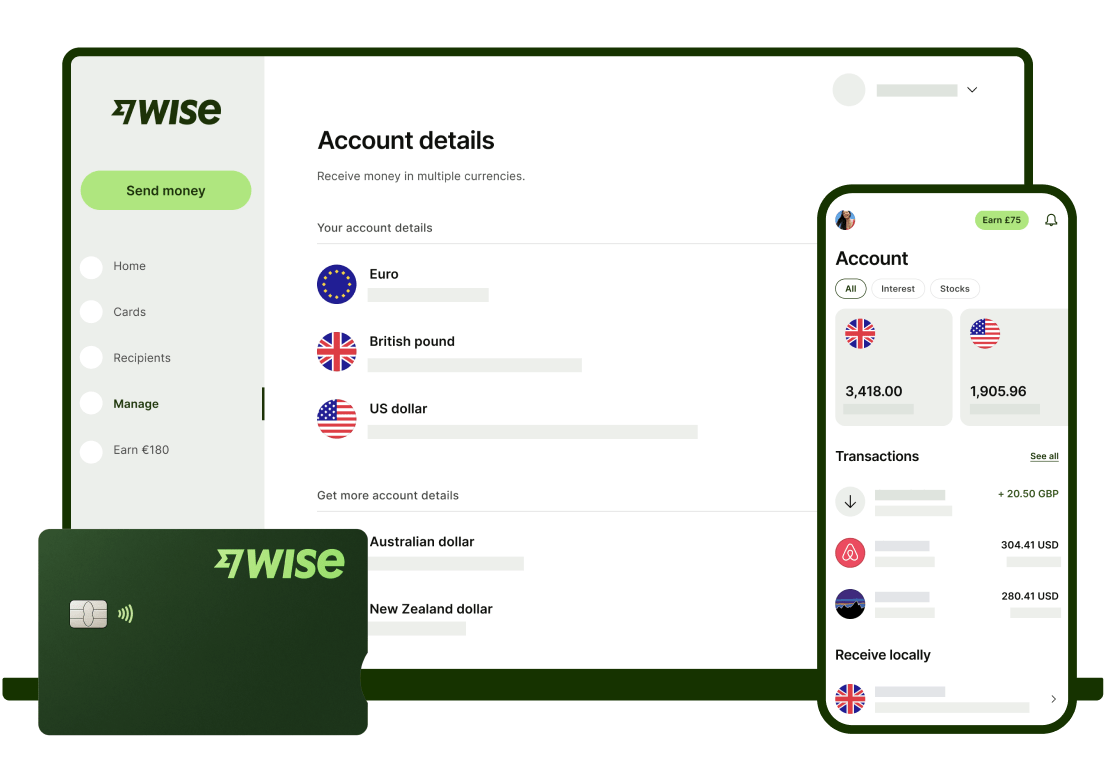5 Ways to Stand Out and Boost Black Friday Sales
Black Friday is the day after Thanksgiving, falling on Friday 29th November in 2024. It’s known for being a perfect time for snagging a bargain, opening the...

You probably have heard of dropshipping or maybe you already have a dropshipping business, but have you ever looked at drop servicing?
In this article we look at what drop servicing is, how it works, some killer ideas for drop servicing in the UK, and how to use Wise Business Account to receive payments for your drop servicing business.
💡 Learn more about Wise Business
Drop servicing is a business model where you:¹
Sell a digital service to a customer.
Pay an external service provider to provide the service under your name.
Deliver the service.
Pocket the difference between what your customer pays and what you pay the service provider.
In other words, you sell a digital service over the internet but outsource the performance of that service. A physical service, like a haircut, must be performed in person but a digital service can be provided to anyone around the world.
Why is drop servicing becoming popular? It allows entrepreneurs to scale their service business faster. Drop servicing is also becoming easier with the emergence of white label service providers and freelancing websites like Upwork and Fiverr. It has never been easier to find good service providers at affordable prices.
A white label service provider is a company that provides an unbranded service that you can customise with your branding, customer service, and other features.²
A digital service differs from a digital product in that a digital service requires outside input from the provider while a digital product can be sold to a customer as is. For example, you can employ a digital marketing company to run an email campaign for you - a digital service. Or you can buy a set of email sales templates which you customise yourself - a digital product.
Drop servicing has several advantages over dropshipping:
1. No delivery costs or delays. Physical goods cost money to ship while a digital service is provided over the internet. Physical delivery can be unpredictable, particularly when suppliers are overseas. This can make good customer service difficult. In contrast, a digital service can be provided over the internet in an instant.
2. Higher margins. Drop servicing tends to have higher margins because services tend to be tailored to the individual customer. Customisation costs more. You don’t just sell a standard SEO blog, you write a blog specific to a business, its audience, and how the audience searches for the product or service the business provides. In contrast, dropshipping tends to sell standardised products made by many different factories. The greater scale of production and competition drives down the margins.
3. Greater potential for recurring income. Digital services often need to be performed again and again. For example, a security audit for a large website needs to be performed several times a year. In contrast, many physical goods only need to be purchased once every few years or more. How often do you need to buy a computer keyboard?

Drop servicing typically has the following steps:
Find a digital service that fits the business model and has market demand.
Find a white label service provider, agency, or freelancer who will work with you to provide the service under your name.
Find customers or pay someone to find customers.
Set a price for the service and take payment - this can be in advance of the service or after delivery. The price needs to be greater than what you are paying the service provider.
Manage the service provider. You monitor the quality and handle any questions from the service provider back to the customer and vice versa.
Pay the service provider and pocket the difference between the price you charged the customer and the price you paid the service provider.
Handle any customer service or follow-up required by the customer.
Demand for digital services keeps evolving and has been boosted by the growth of remote work. Here are some ideas for a new drop servicing business.
1. Online Marketing- From SEO blogs to emails and LinkedIn Posts, online marketing is a booming business. You can come up with the strategy and ideas for content but then pay others to provide the content.
2. Website Design - Use your business understanding and aesthetic sixth sense to design a website but pay someone else to code it or build it on WordPress.
3. Slide presentations- Talk to the customer and edit their text but pay someone else to create the slides using your template and input.
4. Podcast Producing- Take recordings from a customer and then pay someone to turn them into a high-quality podcast and distribute it. Don’t forget the show notes!
5. Youtube intros- Design the intros layout and what links are required but pay someone else to create the intro.
6. Logos- Work with the customer to agree on the logo’s elements. Pay a graphic designer to create several designs.
7. Infographics- Get the data from the client and agree on the draft format. Pay a graphic designer to create the infographic.
7. Online Tutoring- Write a curriculum and lesson plans. Find customers and organise a schedule. But pay someone to teach the individual lessons according to your lesson plans.
8. Architectural plans- Work with a customer to get the basic floor plan and features. Pay an online draughtsman to fill out the plan’s details.
1. Start with a service that people need. Like every new business, first, you need to check whether there is demand for your service. Do people need it and are they willing to pay for it? Talk to potential customers. Start a trial service.
2. Research your competition. Get to know the players in your niche. Who are they? What can you do better? Is there a niche they are neglecting?
3. Register a company. Check with a lawyer, accountant, or online to see what legal form works best for your business. You can find more information about incorporating a company in the UK in our guide.
4. Find online service providers. You need to find good-quality online service providers who can provide the service under your name for a reasonable price. This is critical. If you cannot find a service provider to do the work for you, then you are a freelancer, not a drop servicing entrepreneur. You can find online service providers through friends or platforms like Upwork, Fiverr, and 99designs. It is also wise to check the quality of a service provider by asking them to perform a test job.
3. Agree on terms with the service provider. If the service is simple, you may not need a contract. But if you are supplying your service provider with your intellectual property, such as templates or outlines, or they will have some interaction with the end customer, it is safer to ask them to sign a contract with you. Create a contract once and then use it as a template.
4. Create an online presence for customers to find you. You may be asking yourself: How to get clients for drop servicing? One of the first steps to start getting customers is to know your audience and use the medium that your target customers use. For executives use LinkedIn. For younger audiences use TikTok. You can also set up an online agency on freelancing platforms like Upwork and Fiverr but beware of the fees involved. You don’t always need a website but it is a good start, digital marketing can be a great way to advertise your drop servicing business with low costs.
5. Set up your payment infrastructure. Open a dedicated bank account for your business. If you are providing or outsourcing services all over the word a great way to get paid and pay the service provider in different currencies is to use a multi-currency account like Wise Business.
We’ve discussed the essence of drop servicing so you’ve probably learnt by now that it will require a lot of cost optimization in acquiring the services that you need.

Overseas service providers often provide high-quality work at a reduced price. This can provide an advantage to any drop servicing business. But this also means exposing yourself to high international transfer fees when you pay your overseas contractor using traditional methods like banks or PayPal.
With Wise Business you can make cost-effective international payments to 160+ different countries. You can convert between currencies at the mid-market rate so you’re sure that your recipient will get the exact amount you sent.
Wise Business also offers a multi-currency account so you can receive payment from international customers like a local in 8+ major currencies.
Get started with Wise Business 🚀
Sources used in this article:
Sources last checked 22/05/2024
*Please see terms of use and product availability for your region or visit Wise fees and pricing for the most up to date pricing and fee information.
This publication is provided for general information purposes and does not constitute legal, tax or other professional advice from Wise Payments Limited or its subsidiaries and its affiliates, and it is not intended as a substitute for obtaining advice from a financial advisor or any other professional.
We make no representations, warranties or guarantees, whether expressed or implied, that the content in the publication is accurate, complete or up to date.

Black Friday is the day after Thanksgiving, falling on Friday 29th November in 2024. It’s known for being a perfect time for snagging a bargain, opening the...

Black Friday - Friday 29th November in 2024 - kicks off the end of year shopping period, with huge uplifts in on and offline sales as people grab a bargain...

Leveraging technology in business has always been a smart way to get ahead of the game. But with the fast pace of tech advancements we’ve seen recently,...

Read our guide to the best accounting software for startups in the UK, including QuickBooks, Sage, Xero, NetSuite, FreshBooks and FreeAgent.

Read our essential guide to the best business bank accounts for startups in the UK, comparing all of the most popular providers

Read our guide to the best online business bank accounts in the UK, including Tide, Starling, Revolut, ANNA and Wise Business.